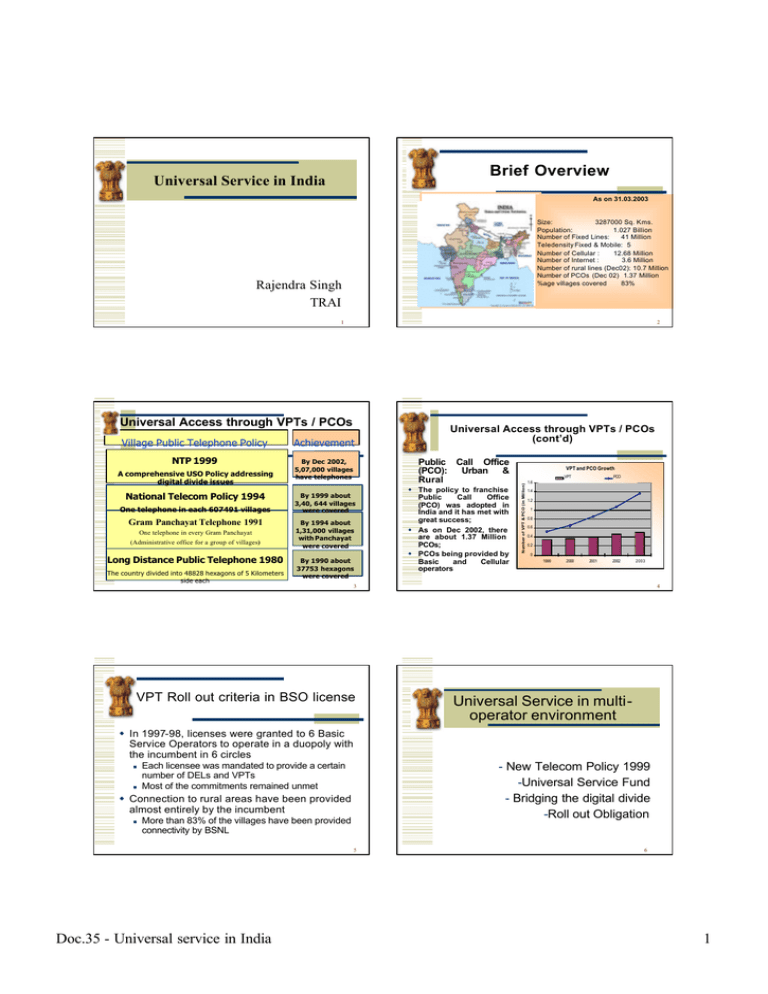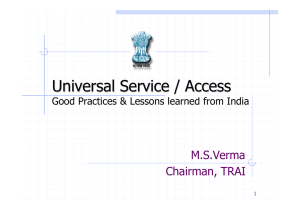Brief Overview Universal Service in India
advertisement

Brief Overview Universal Service in India As on 31.03.2003 Size: 3287000 Sq. Kms. Population: 1.027 Billion Number of Fixed Lines: 41 Million Teledensity Fixed & Mobile: 5 Number of Cellular : 12.68 Million Number of Internet : 3.6 Million Number of rural lines (Dec02): 10.7 Million Number of PCOs (Dec 02) 1.37 Million %age villages covered 83% Rajendra Singh TRAI 1 2 Village Public Telephone Policy Achievement NTP 1999 By Dec 2002, 5,07,000 villages have telephones A comprehensive USO Policy addressing digital divide issues National Telecom Policy 1994 One telephone in each 607491 villages Gram Panchayat Telephone 1991 One telephone in every Gram Panchayat (Administrative office for a group of villages) Long Distance Public Telephone 1980 The country divided into 48828 hexagons of 5 Kilometers side each Universal Access through VPTs / PCOs (cont’d) Public Call Office (PCO): Urban & Rural By 1999 about 3,40, 644 villages were covered By 1994 about 1,31,000 villages with Panchayat were covered By 1990 about 37753 hexagons were covered w The policy to franchise Public Call Office (PCO) was adopted in India and it has met with great success; w As on Dec 2002, there are about 1.37 Million PCOs; w PCOs being provided by Basic and Cellular operators VPT and PCO Growth VPT Number of VPT & PCO (in Million) Universal Access through VPTs / PCOs PCO 1.6 1.4 1.2 1 0.8 0.6 0.4 0.2 0 1999 2000 2001 2002 2003 3 VPT Roll out criteria in BSO license 4 Universal Service in multioperator environment w In 1997-98, licenses were granted to 6 Basic Service Operators to operate in a duopoly with the incumbent in 6 circles n n - New Telecom Policy 1999 -Universal Service Fund - Bridging the digital divide -Roll out Obligation Each licensee was mandated to provide a certain number of DELs and VPTs Most of the commitments remained unmet w Connection to rural areas have been provided almost entirely by the incumbent n More than 83% of the villages have been provided connectivity by BSNL 5 Doc.35 - Universal service in India 6 1 Objectives of NTP’99 in Section 2.0 (Extracts relevant to Universal Service) w Availability of affordable and effective communications for the citizens is at the core of the vision and goal of the telecom policy. w Transform in a time bound manner, the telecommunications sector to a greater competitive environment in both urban and rural areas providing equal opportunities and level playing field for all players; w Strive to provide a balance between the provision of universal service to all uncovered areas, including the rural areas, and the provision of high-level services capable of meeting the needs of the country’s economy; w Encourage development of telecommunication facilities in remote, hilly and tribal areas of the country; Targets in NTP’ 99 w Make available telephone on demand by the year 2002 and sustain it thereafter so as to achieve a teledensity of 7 by the year 20 05 and 15 by the year 2010 w Encourage development of telecom in rural areas making it more affordable by suitable tariff structure and making rural communication mandatory for all fixed service providers. w Increase rural teledensity from the current level of 0.4 to 4 by the year 2010 and provide reliable transmission media in all rural areas. (Current rural teledensity: 1.1) w Achieve telecom coverage of all villages in the country and provide reliable media to all exchanges by the year 2002. w Provide Internet access to all district head quarters by the year 2000 w Provide high speed data and multimedia capability using technologies including ISDN to all towns with a population great er than 2 lakh by the year 2002 (USO Policy) 7 New Telecom Policy 1999: Section 6 l l l 8 Universal Service Funding Provide voice and low speed data service to the balance 2.9 lakh uncovered villages in the country by the year 2002 (Covered in USO Policy) Achieve Internet access to all district head quarters by the year 2000 (Achieved) Achieve telephone on demand in urban and rural areas by 2002 § NTP’99 laid down the mechanism of universal service fund (USF) to be created through Universal Service Levy which would be a percentage of revenue earned by all the operators under various licenses 9 Universal Service Policy Issues for Consultation w NTP’99 set specific targets for Universal Service and also provided the mechanism for funding it; w The government sought TRAI’s recommendations on the subject w To work out the implementation details, TRAI carried out a comprehensive study and released a consultation paper; n Available at http://www.trai.gov.in/indx.htm w Based on the consultation process, TRAI provided its recommendations to the government; n Available at http://www.trai.gov.in/recom.htm w The government released USO guidelines in 2002. n Available at http://www.dotindia .com/uso /usoindex .htm w USO Fund has become effective w.e.f 1.4.2002 11 Doc.35 - Universal service in India 10 w Consultation paper on USO invited comments of the stakeholders on n Scope of USO (Access / DELs / PTIC) n Who will Pay? (All operators / any exception) n How much to contribute as %age of revenue? n Who will get? n What should be the methodology for disbursement? n How will the Universal Access Levy be collected? 12 2 Approaches to funding Universal Service Approaches to funding Universal Service w Approaches to funding Universal Service considered by TRAI while providing its recommendations n Cross subsidy between Services n Access Deficit Charge n Roll out Obligations in License l w Bidding Approach, Chile, Peru w Per DEL subsidy l Incumbent’s Liability l Other incentives w India, all parts of the world w UK w USA, Canada w Sri Lanka (1 rural telephone = 10 normal telephone for the purpose of roll out), one time subsidy of Rs 50,000/= to 3000 phones w Brazil, India n Universal Service Fund l w Special home zone tariffs w Use of Cellular Service like Grameen Phone, ESCOTEL in U.P. Area Approach w High Cost Area Approach, USA w Avoidable Cost Area Approach, Australia 13 TRAI provided its recommendations to the government, which then released the final guidelines 14 USO guidelines USO guidelines (cont’d) Establishment of USO Fund § Government of India issued USO guidelines in March 2002 based upon TRAI’s recommendations § Setting up of a Universal Service Fund (USF) with a percentage of Revenue contribution as Universal Service Levy by all telecom service providers except pure value added service providers. § Date of implementation of USF support (1- 4-2002) § USF presently to be administered by Deptt. Of Telecom (DOT), Government of India § USO subsidy through a bidding process § At present Government Subsidy USL is around 5% of adjusted gross revenue § USF support to public access telephones (VPTs); § Only deficit in Opex for VPTs 6.07 lakh VPTs § Tender has already been awarded § Replacement of old VPTs installed on Multi Access Radio Relay (MARR) technology (about 200,000) § Deficit in Capex and Opex § Tender to be carried out shortly § Provision of additional rural community phone in villages exceeding population of 2000 § Deficit in Capex and opex 15 16 Achieve telephone on demand in urban and rural areas by 2002 USO guidelines (cont’d) w Today the waiting list is about 1 Million § Upgradation of VPTs to Public Telecom and Info Centres (PTICs) within 5 kms of every village and at least in all villages with rural post offices to provide data transmission facilities by the year 2004; l l w The reason for existence of this waiting list could be; § Deficit in Capex and opex § Installation of 5400 high speed PTICs for Tele -education and Tele -Medicine purpose by the year 2004, n § Deficit in Capex and opex Non availability of access l § USF support to individual telephones in high cost rural/remote areas l n § Deficit in Capex and opex for new lines Non availability of fixed lines; Non availability of Cellular coverage; Unaffordable access l 17 Doc.35 - Universal service in India Most of the waiting list in rural areas Objective of providing telephone on demand in Urban areas largely met Unaffordable tariff for Cellular connection as rural tariffs are much lower 18 3 Funding Sources for USO in India Rural Telephony status n n Now migrated to a combination with ADC Access Deficit Charge (ADC) to compensate for low rentals & free calls for fixed services w USO Funding from License fees n Over and above the compensation from other sources (a pure incentive to get back a portion of license fees paid); w Government grant n Government grants to incumbent w There are presently about 27000 Rural exchanges in the country; w The number of Rural lines were about 10.33 Million by Dec 2002; w The tariffs for rural areas are set keeping in view the affordability criteria; Rural DELs 12000 10000 Rural DELs (in '000s) w Tariff Cross Subsidy 8000 6000 4000 2000 0 95-96 96-97 97-98 98-99 99-00 2000- 200101 02 2003 Dec 19 20 How is data access different from providing voice access? IT for rural masses The special issues that arise in providing data access and application services are It often requires network upgradation and certainly needs much more powerful and expensive end user equipment Importance of content especially 3rd party (in contrast to voice where content was user generated), It requires more user awareness, the network is required to be rugged and at the same time highly reliable • Bridging the Digital Divide • • • 21 22 How to make available data capable network to the rural areas in a time bound manner? Dial-up Modem is the best solution on the existing wireline DELs; l Wireless Access systems such as GSM, CorDECT, WLL (M) are now increasing at a much faster rate l Making available data capable network to the rural areas – promoting access w USO Fund mechanism is in place to ensure a certain minimum level of data access in rural / remote areas; Wireless Mobile as percentage of total in India 20 18 16 n 14 12 10 8 6 4 2 0 March '99 Mar-00 Mar-01 Mar-02 Sep'02 It is important to keep in mind the form in which rural access shall manifest itself in the future for data services 23 Doc.35 - Universal service in India PTICs & HPTICs § With the growth in deployment of new wireless access technology, data coverage in rural areas would improve tremendously; § As affordability is an important criteria in rural areas, Innovation would need to be done so as to convert these access points from one way to both way; such as using voice mail or smart cards; 24 4 Striking a balance between funding the service provisioning and making the project self sustainable? Making available data capable network to the rural areas – promoting DELs n w Growth of individual telephones in rural areas largely driven by availability and affordability; n l The average willingness to spend on telecom services is less than 1 % of household income in most of the areas in the country; n n n Low cost data capable technologies are, therefore, a necessity; Costs are coming down with the increase in number; High cost of Customer Premises Equipment is a major hurdle, be ti a computer or a data capable mobile; A number of indigenous efforts are also underway such as CorDECT, SIMPUTER, Digital Gangetic Plain research programme of Medialab and IIT etc. Subscriber himself: Add value to the existing voice services so as to increase productivity. For example w Imparting Mobility to the PCO; Grameen Phone w Providing services such as e -Governance, e-Commerce, exam results etc, for which the user would have to spend higher amount / more time through traditional means e.g. eGovernance in Gyandoot; w Today, the tariffs for rural areas are set keeping in view the affordability criteria; w To promote growth it is necessary to either reduce the cost or increase the spending of an individual; n Funding sources; l l l l Endeavour should be to tap funding from sources that can generate additional revenue as a result of ICT; When Internet kiosks are deployed there would be additional streams of revenue from other activities such as DTP, e-learning, entertainment etc. Government support; From Interconnection; 25 26 What can be done to promote content that increase the productivity of masses and provide them with their value for money? n Internet Kiosks Take the government to the people (e-governance); w ICT serves as an excellent means to bridge the gaps (distance gap, communication gap, between rural areas and governance; opportunity w Popularly known as Internet Dhabas w Internet Dhabas in 3485 out of 6332 Blocks available; w Internet Access available nationwide on local dialing gap) w The government has to take the lead and carry out large scale computerisation and networking of information database; w Entrepreneur based models will have to be promoted so that there are higher performance incentives and innovation; w E.g. Bhoomi project in Karnataka, e-Seva in A.P., Gyandoot in M.P. n Bring the people to the government w Create framework to promote e -Commerce e.g. Internet Tambon Project in Thailand One Tambon one product 27 Gyandoot services (examples) Sl. No. Name of Service 1 2 3 4 5 6 7 8 9 10 11 12 13 Grievance Redressal Caste certificate Domicile certificate Income certificate Land records Auction prices Driving license th th Online results of 10 /12 board exams Hindi e - mail Employment registration Social Security Pension Old age Pension Matrimonials Retail tariff (in Indian rupees) 10 10 10 10 15 5 20 10 10 10 10 10 25 Revenue for kiosk owners – Project Gyandoot Average income per annum of a kiosk: Delivery time frame (in days) Gyandoot services Job work / data entry Training and education Miscellaneous Average recurring expenditure (electricity, maintenance etc. Net income 7 15 7 7 10 Immediate 10 Immediate 15 10 10 29 Doc.35 - Universal service in India 28 $ 1 US = Rs 50 Rs. 24000 Rs. 6000 Rs. 16000 Rs. 2000 Rs. 12000 Rs. 36000 (US $ 720 per annum)30 5 Promoting awareness l l l l Rural Telecom incentives Formal ICT education is required at all the level to create awareness in the forthcoming generation; Awareness can come only when interaction with ICT is a usual feature of their day-to- day life such as a Radio; As literacy rate remains at just 65 %, the ICT kiosks in our country would need to be manned by local people, who can act as an interface; Awareness will need to be increased through larger community participation in ICT applications n l l n n w In Thailand, local teachers were involved in making the web-sites for the products in the area w When Internet kiosks are opened, there are a number of e- learning activities that start on its own or on the initiative of the kiosk owner Market size n The present rural teledensity is just about 1.1%. Even if we target a teledensity of 4% by 2010, there is a market of 33 Million lines in the coming 7 years; An opportunity to get back a portion of license fees through USO support; An opportunity to tap the large potential of other associated markets in rural areas by brand building; Harnessing the Indian software skills, which is available at reasonable price to gain the competitive advantage 31 Experiences & Lessons Current initiatives w USO Fund has been established; w USO Fund Administrator has already concluded the bidding for first phase of policy implementation i.e., VPT maintenance and the operational expenses; w Second phase in progress w With growing competition private sector is also entering rural areas; w Synergy with Information technology applications such as e-governance, e- learning and e-commerce being facilitated to promote Universal Service. 33 Experiences & Lessons (Cont’d) 1. Multi -pronged approach combining various policies: a)Licensing Policy b)Funding Policy c)Technology Development Policy d) Tariff Policy e) Diversified content developments for different applications in different languages 2. Achieving USO not possible only by including it in the License conditions 34 Experiences & Lessons (Cont’d) 3. Implementation should be based on clear economic principles, so that USO becomes commercially viable in the short run and till it has to be subsidized the source and extent of subsidy should be clearly identified 4. Services constituting USO (regarding USO content) will need to be clearly defined. 5. Need to meet not only the basic minimum requirement of connectivity (access) but also to create conditions to reduce the digital divide. 6. Periodic review of both the USO content and requirements of USO funds would be necessary 35 Doc.35 - Universal service in India 32 7. A time frame for implementation should be provided 8. Where necessary, USO should be implemented in phases and the services to be covered under the programme should be clearly prioritized 9. Indigenous technology helps in reduction of the cost and achieving adaptability to local conditions resulting in increased reliability and sustained interest of users 10. Tariff Policies to be supportive of USO programs 11. Need to focus on increasing the utility and acceptability of the service to the society e.g. content development for wide scale coverage of e-services, such as e-learning, e-governance and e-commerce 36 6 Thank You -Rajendra Singh, TRAI, India -July, 2003 37 Doc.35 - Universal service in India 7




